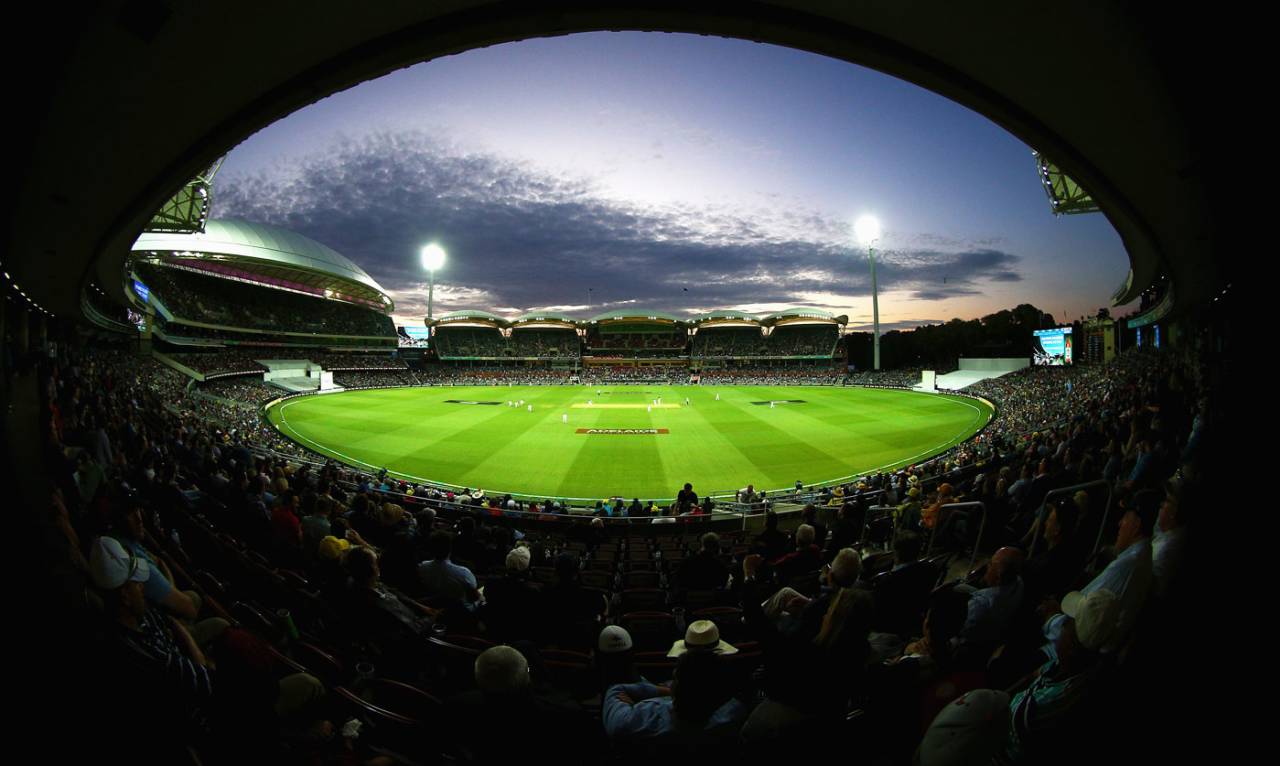Pink-ball cricket is a mere bulge in Test cricket's fabric
It's too soon to draw conclusions from the Adelaide Test, but going by the game's history, it won't be long before day-night Tests simply become Tests
Jon Hotten
30-Nov-2015

The future is here and it's not so different from the present • Getty Images
Every cricketer will be horribly familiar with the anxiety dream. Mine has remained steadfast through the years of playing: I'm in the dressing room and next man in. A wicket has fallen but I can't tie my laces up or get my pads on. Ricky Ponting once said that his was getting lost in a vast pavilion as he walked out to bat. The dream probably has as many variations as there are players, but it means the same thing, comes from the same place.
So it's easy to imagine David Warner or Steve Smith rubbing their eyes and saying something like: "Man, that was a weird one… I was playing in a Test match, but it was night time, full house at the Adelaide Oval… The ball was… pink. And the worst part was, it was hooping around corners. Couldn't get a bat on it, mate…"
There has been something dreamlike about the first day-night Test, especially as the sun set on the very first day, a fiery ball dipping down towards the city of churches, the ground renovation starting to make sense for the first time as the light touched the stands. The vision was, if not futuristic, utterly contemporary, a Hollywood remake of an enduring classic.
Cricket needed this. And specifically Test cricket needed this. And especially Test cricket everywhere other than England, the only place where it consistently sells out. The contrast between Adelaide and the yawning emptiness of the Gabba was vivid. It's the smallest of sample sizes, of course, and novelty plays a part, but the game must adapt and accelerate to match the culture in which it exists. The people want what the people want. The trick is to somehow retain its timeless elements, the fundamental depths of its playing and psychology, while fitting it to the lives of its consumers.
It's tempting to use a single match to construct a paradigm of what day-night Test cricket will be like: the bowler-friendly ball and the bowler-friendly post-dinner session that catapult the game along and demand a defensive response from batsmen.
Yet imagine trying to draw conclusions from the first ever one-day international played at the Melbourne Cricket Ground on January 5, 1971. England scored 190 all out from 39.4 of their allotted 40 overs, Australia skating past them quite comfortably in the 35th over. Not entirely terrible, you may think, until you realise that these were eight-ball overs. England's innings contained seven boundaries. It hardly looked like the future of anything.
The trick is to somehow retain cricket's timeless elements, the fundamental depths of its playing and psychology, while fitting it to the lives of its consumers
But 46,000 people turned up to watch a match arranged as a stopgap for a rain-ruined Test. The demand was immediate. The people want what the people want.
When Australia played New Zealand in the first T20 international, on February 17, 2005, <>iWisden reported: "Both teams wore garish body-hugging kits last seen in the 1980s, while the New Zealanders went one stage further and sported all manner of outmoded facial hair, creating a cabaret feel." Ricky Ponting said afterwards, "I think it's difficult to play seriously."
The second T20I happened four months later, in front of a heaving crowd at the Rose Bowl, where England's bullying win over Australia served notice for that immortal summer. Such was the fervour, and so quickly was the format gaining ground, that Andrew Miller reported for this site: "Last night's tussle might just have brought the prospect of a Twenty20 World Cup one step closer."
The people want what the people want.
Test match cricket is the game's lodestone. Were WG, great whiskered creator of the modern form, to be brought back to life to glimpse the here and now, imagine explaining to him the concept of the internet or the Mars Rover. But sit him down at Adelaide Oval and once he had got over the lights and the way Steve Smith walks around the batting crease, he would find a deep and comforting familiarity. This is the time that Test cricket has spanned. Playing a night session is the merest bulge in its fabric.
Just as there will soon be no professional players who knew an era before T20 cricket, there will come a time - not far off in the scheme of things - when playing with a pink ball will be as natural as playing with the red or the white. The current players, who must adapt without having been reared on it, have it toughest. With what we know about the physiology of human reaction to the moving cricket ball, it's reasonable to assume that there are minute but significant differences in sighting and hitting a ball of a different colour. On television the pink ball has a vaguely fluorescent shimmer that seems to leave the slightest trail of pixels behind it. The pink balls that I have played with feel lighter, which is certainly a trick of colour perception. The dye also has a powdery quality that feels less organic than either red or white.
It is different and we must live with its discomfort for a while. It's just a blip in time for a game that has seen it all and more.
The people want what the people want.
Jon Hotten blogs here. @theoldbatsman